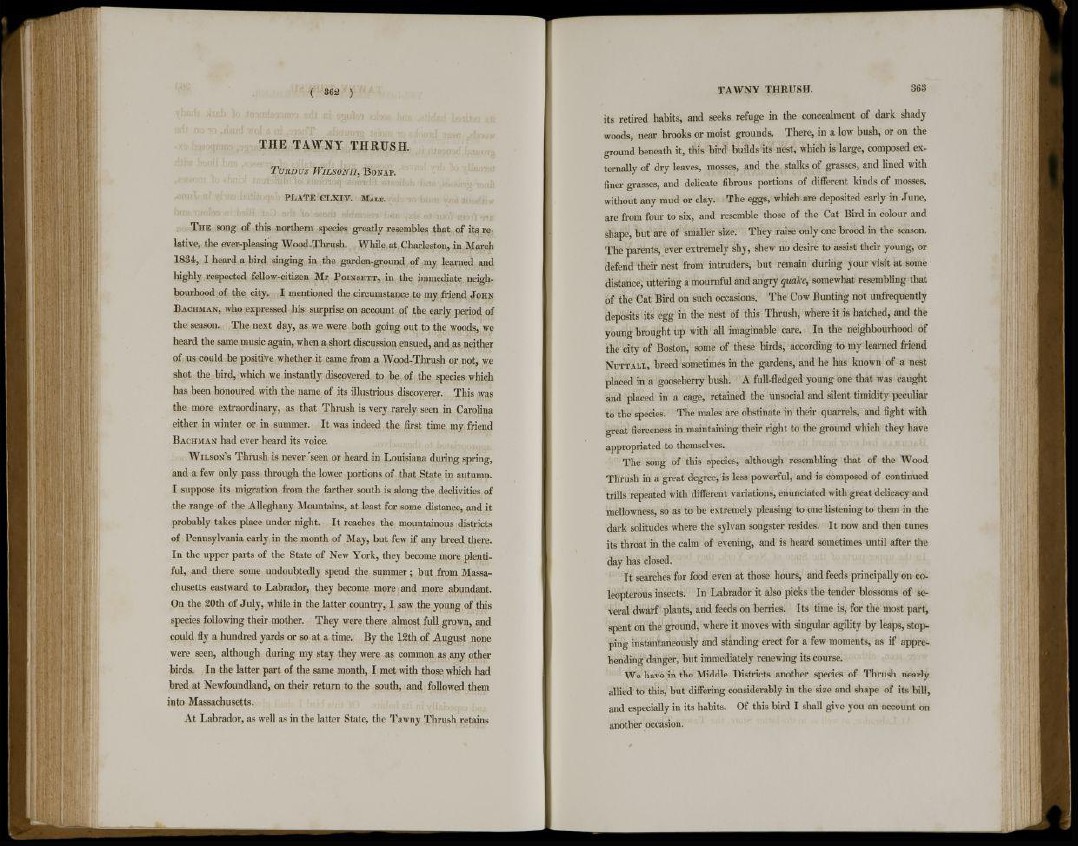
( 362 )
T H E T A W N Y T H R U S H .
TURDUS WlLSONII, BONAP.
P L A T E C L X I V . MALE.
•
T H E song of this northern species greatly resembles that of its relative,
the ever-pleasing Wood-Thrush. While at Charleston, in March
1834, I heard a bird singing in the garden-ground of my learned and
highly respected fellow-citizen Mr POINSETT, in the immediate neighbourhood
of the city. I mentioned the circumstance to my friend JOHN
BACHMAN, who expressed his surprise on account of the early period of
the season. The next day, as we were both going out to the woods, we
heard the same music again, when a short discussion ensued, and as neither
of us could be positive whether it came from a Wood-Thrush or not, we
shot the bird, which we instantly discovered to be of the species which
has been honoured with the name of its illustrious discoverer. This was
the more extraordinary, as that Thrush is very rarely seen in Carolina
either in winter or in summer. It was indeed the first time my friend
BACHMAN had ever heard its voice.
WILSON'S Thrush is never seen or heard in Louisiana during spring,
and a few only pass through the lower portions of that State in autumn.
I suppose its migration from the farther south is along the declivities of
the range of the Alleghany "Mountains, at least for some distance, and it
probably takes place under night. It reaches the mountainous districts
of Pennsylvania early in the month of May, but few if any breed there.
In the upper parts of the State of New York, they become more plentiful,
and there some undoubtedly spend the summer; but from Massachusetts
eastward to Labrador, they become more and more abundant.
On the 20th of July, while in the latter country, I saw the young of this
species following their mother. They were there almost full grown, and
could fly a hundred yards or so at a time. By the 12th of August none
were seen, although during my stay they were as common as any other
birds. In the latter part of the same month, I met with those which had
bred at Newfoundland, on their return to the south, and followed them
into Massachusetts.
At Labrador, as well as in the latter State, the Tawny Thrush retains
TAWNY THRUSH. 363
its retired habits, and seeks refuge in the concealment of dark shady
woods, near brooks or moist grounds. There, in a low bush, or on the
ground beneath it, this bird builds its nest, which is large, composed externally
of dry leaves, mosses, and the stalks of grasses, and lined with
finer grasses, and delicate fibrous portions of different kinds of mosses,
without any mud or clay. The eggs, which are deposited early in June,
are from four to six, and resemble those of the Cat Bird in colour and
shape, but are of smaller size. They raise only one brood in the season.
The parents, ever extremely shy, shew no desire to assist their young, or
defend their nest from intruders, but remain during your visit at some
distance, uttering a mournful and angry quake, somewhat resembling that
of the Cat Bird on such occasions. The Cow Bunting not unfrequently
deposits its egg in the nest of this Thrush, where it is hatched, and the
young brought up with all imaginable care. In the neighbourhood of
the city of Boston, some of these birds, according to my learned friend
NUTTALL, breed sometimes in the gardens, and he has known of a nest
placed in a gooseberry bush. A full-fledged young one that was caught
and placed in a cage, retained the unsocial and silent timidity peculiar
to the species. The males are obstinate in their quarrels, and fight with
great fierceness in maintaining their right to the ground which they have
appropriated to themselves.
The song of this species, although resembling that of the Wood
Thrush in a great degree, is less powerful, and is composed of continued
trills repeated with different variations, enunciated with great delicacy and
mellowness, so as to be extremely pleasing to one listening to them in the
dark solitudes where the sylvan songster resides. It now and then tunes
its throat in the calm of evening, and is heard sometimes until after the
day has closed.
It searches for food even at those hours, and feeds principally on coleopterous
insects. In Labrador it also picks the tender blossoms of several
dwarf plants, and feeds on berries. Its time is, for the most part,
spent on the ground, where it moves with singular agility by leaps, stopping
instantaneously and standing erect for a few moments, as if apprehending
danger, but immediately renewing its course.
We havein the Middle Districts another species of Thrush nearly
allied to this, but differing considerably in the size and shape of its bill,
and especially in its habits. Of this bird I shall give you an account on
another occasion.